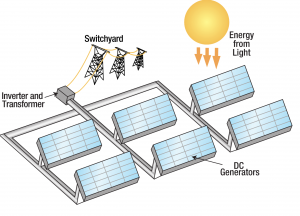Researchers at Michigan State University have redefined the future of solar power applications. Unlike conventional solar panels, this light harvesting technology is transparent and nearly as efficient in converting light into electricity.
The need for effective and cost efficient technology has never been higher. As global energy consumption moves away from fossil fuels, solar powered energy has become a key player in the green energy sector. Solar cells can supply a substantial amount of energy, but they need to be deployed over a large area. Theoretically, a solar installation that covers 20% of Nevada could power the entire United States.

Schematic of current solar panel use.
Solar panels work by using the energy from light rays to bump electrons from atoms, generating a flow of electricity. Typically, solar panels comprise of many photovoltaic cells, simply meaning they convert sunlight into electricity.

Traditional panels are not enough to produce sustainable energy.
Traditional solar panels have been integrated in many areas and are often found on top of homes or tall buildings. Although this have proven to moderately effective, MSU researchers believe that this new technology will drastically expand photovoltaic applications. The thin, plastic-like material can be used on building facades, windows, cell phones and other devices with a clear surface.
As the direct pathway of sunlight varies temporally and spatially, increasing the possible areas in which energy can be harvesting also increases the absorption potential. Researchers from the University of Lisbon find that having photovoltaic cells on two or three building facades and windows could significantly increase the amount of electricity produced.
It is estimated that there is 5-7 billion square meters of glass surface area in the US. With this amount alone, solar technologies could supply almost 40% of the United States power demand. When combined with traditional solar panels, solar energy could become a major global producer of energy.
See-through solar-harvesting technologies are pioneering the expansion of solar powered applications and their implications could have a huge impact on clean energy in the future.
-Mya Dodd
